SUBARU BRZ 2014 1.G Owners Manual
Manufacturer: SUBARU, Model Year: 2014, Model line: BRZ, Model: SUBARU BRZ 2014 1.GPages: 488, PDF Size: 6.41 MB
Page 351 of 488
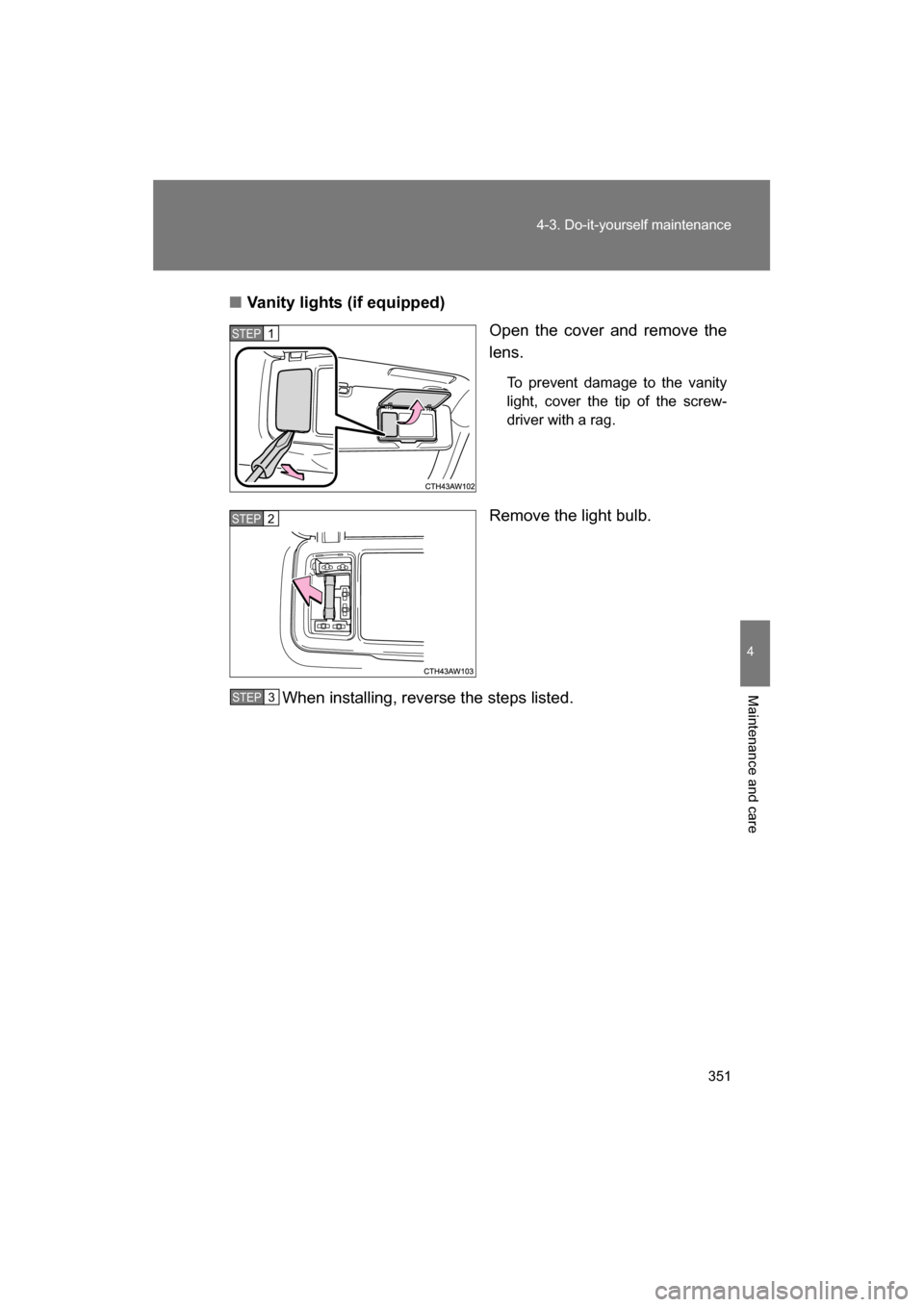
351
4-3. Do-it-yourself maintenance
4
Maintenance and care
■Vanity lights (if equipped)Open the cover and remove the
lens.
To prevent damage to the vanity
light, cover the tip of the screw-
driver with a rag.
Remove the light bulb.
When installing, reverse the steps listed.
STEP 1
STEP 2
STEP 3
Page 352 of 488
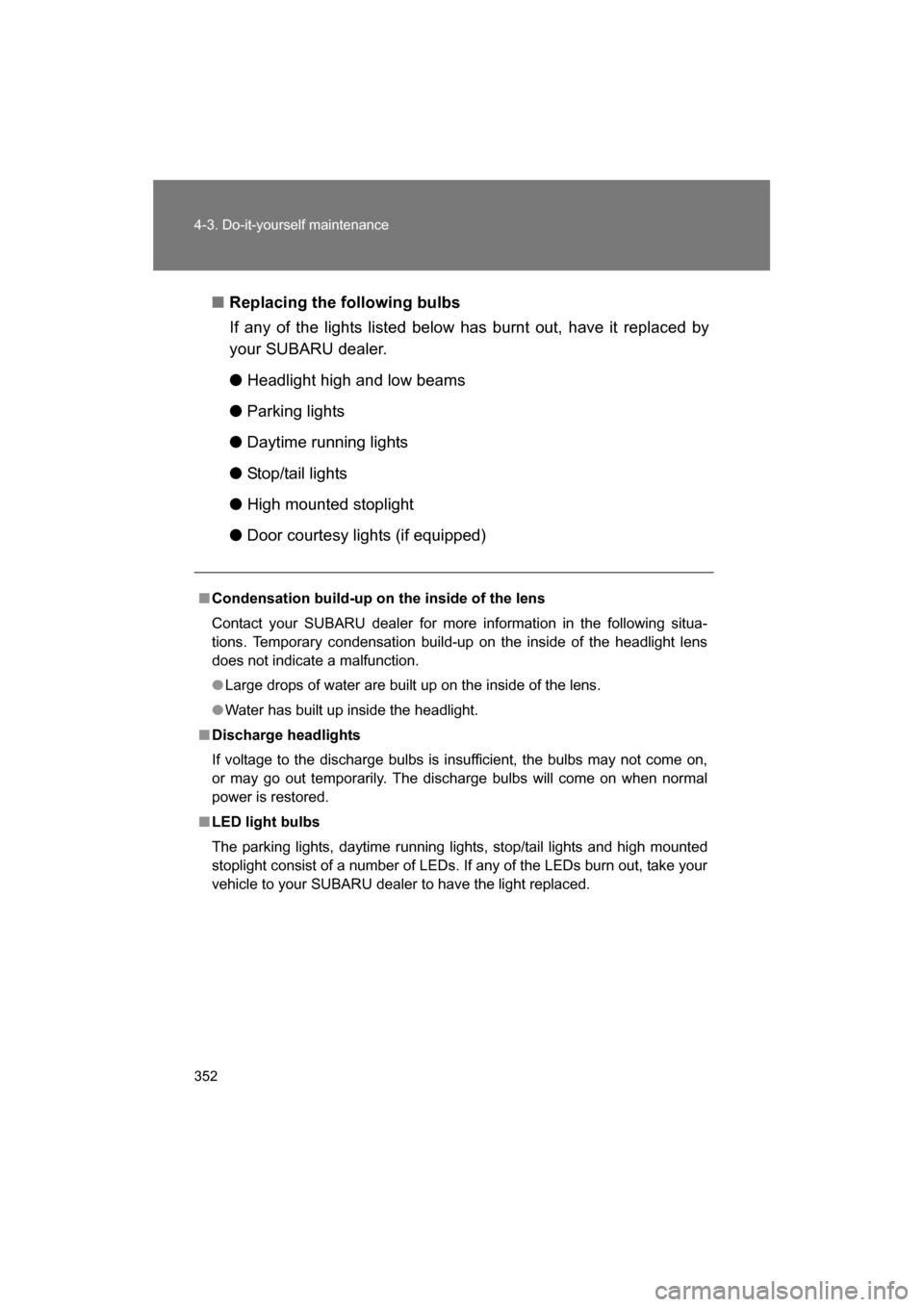
352
4-3. Do-it-yourself maintenance
■Replacing the following bulbs
If any of the lights listed below has burnt out, have it replaced by
your SUBARU dealer. ●Headlight high and low beams
● Parking lights
● Daytime running lights
● Stop/tail lights
● High mounted stoplight
● Door courtesy lights (if equipped)
■Condensation build-up on the inside of the lens
Contact your SUBARU dealer for more information in the following situa-
tions. Temporary condensation build-up on the inside of the headlight lens
does not indicate a malfunction.
●Large drops of water are built up on the inside of the lens.
●Water has built up inside the headlight.
■Discharge headlights
If voltage to the discharge bulbs is insufficient, the bulbs may not come on,
or may go out temporarily. The di scharge bulbs will come on when normal
power is restored.
■LED light bulbs
The parking lights, daytime running lights, stop/tail lights and high mounted
stoplight consist of a number of LEDs. If any of the LEDs burn out, take your
vehicle to your SUBARU dealer to have the light replaced.
Page 353 of 488
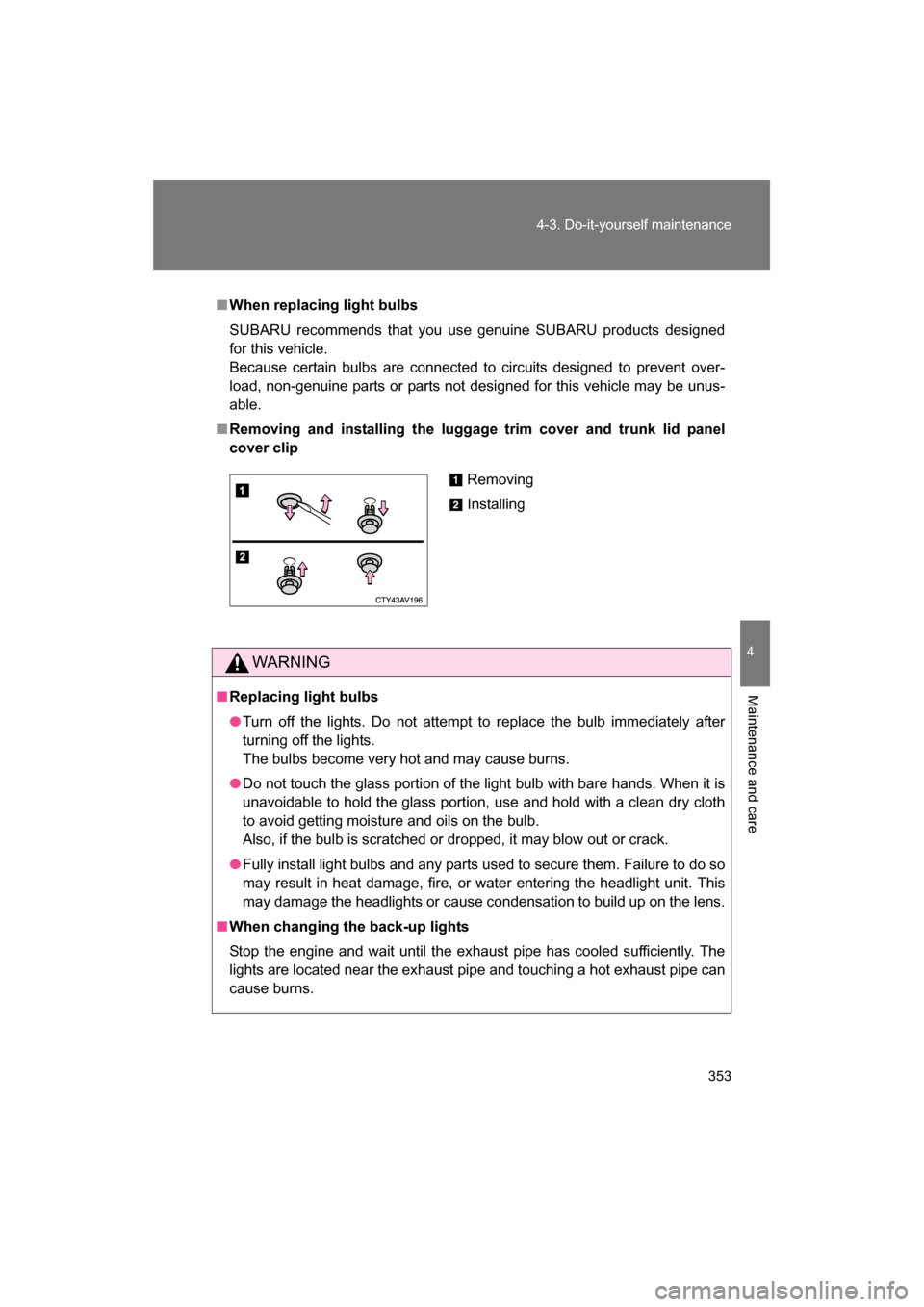
353
4-3. Do-it-yourself maintenance
4
Maintenance and care
■When replacing light bulbs
SUBARU recommends that you use genuine SUBARU products designed
for this vehicle.
Because certain bulbs are connected to circuits designed to prevent over-
load, non-genuine parts or parts not designed for this vehicle may be unus-able.
■Removing and installing the luggage trim cover and trunk lid panel
cover clip
WARNING
■Replacing light bulbs
●Turn off the lights. Do not attempt to replace the bulb immediately after
turning off the lights.
The bulbs become very hot and may cause burns.
●Do not touch the glass portion of the light bulb with bare hands. When it is
unavoidable to hold the glass portion, use and hold with a clean dry cloth
to avoid getting moisture and oils on the bulb.
Also, if the bulb is scratched or dropped, it may blow out or crack.
●Fully install light bulbs and any parts used to secure them. Failure to do so
may result in heat damage, fire, or water entering the headlight unit. This
may damage the headlights or cause condensation to build up on the lens.
■When changing the back-up lights
Stop the engine and wait until the exhaust pipe has cooled sufficiently. The
lights are located near the exhaust pipe and touching a hot exhaust pipe can
cause burns.
Removing
Installing
Page 354 of 488
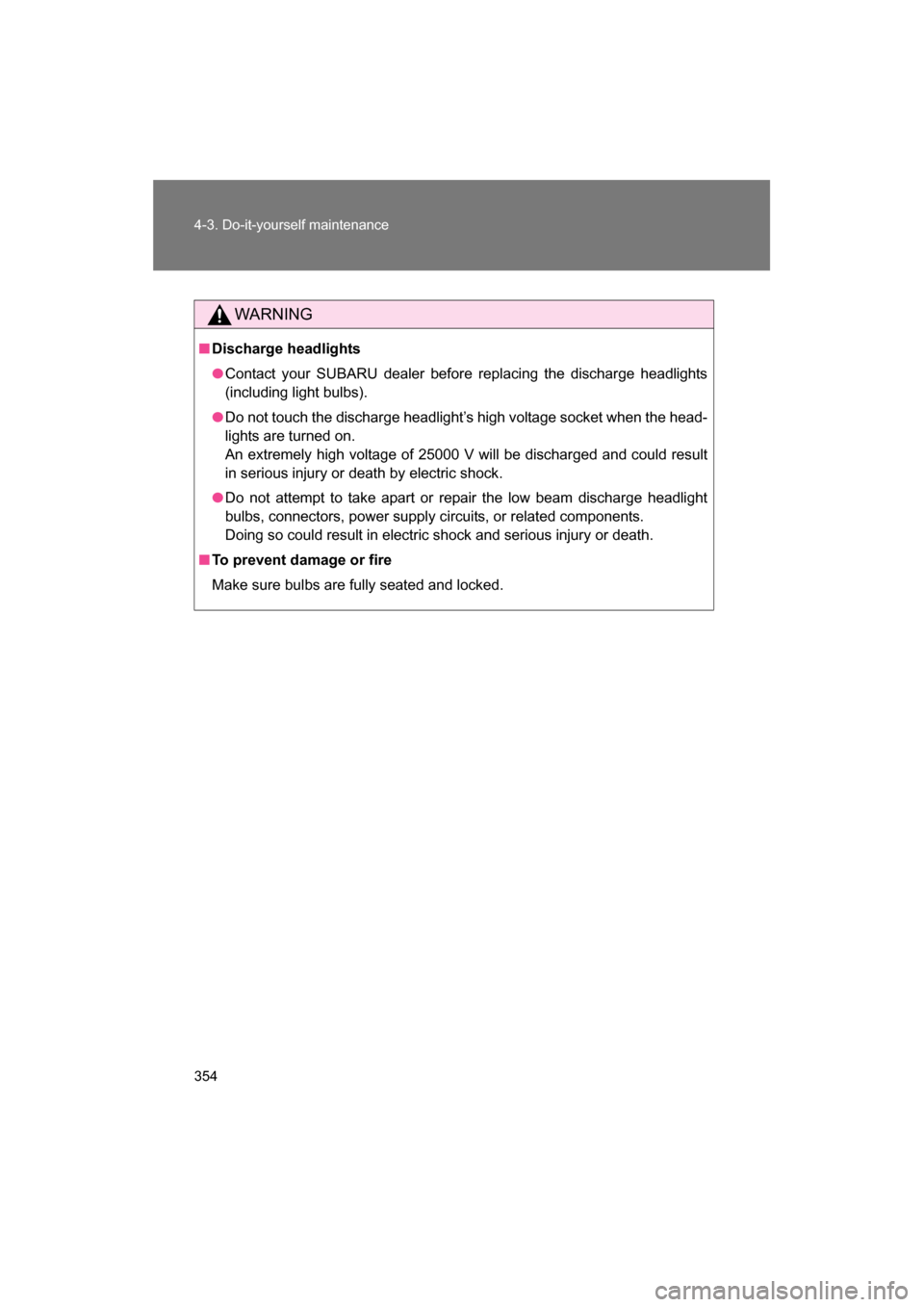
354
4-3. Do-it-yourself maintenance
WARNING
■Discharge headlights
●Contact your SUBARU dealer before replacing the discharge headlights
(including light bulbs).
●Do not touch the discharge headlight’s high voltage socket when the head-
lights are turned on.
An extremely high voltage of 25000 V will be discharged and could result
in serious injury or death by electric shock.
●Do not attempt to take apart or repair the low beam discharge headlight
bulbs, connectors, power supply circuits, or related components.
Doing so could result in electric shock and serious injury or death.
■To prevent damage or fire
Make sure bulbs are fully seated and locked.
Page 355 of 488
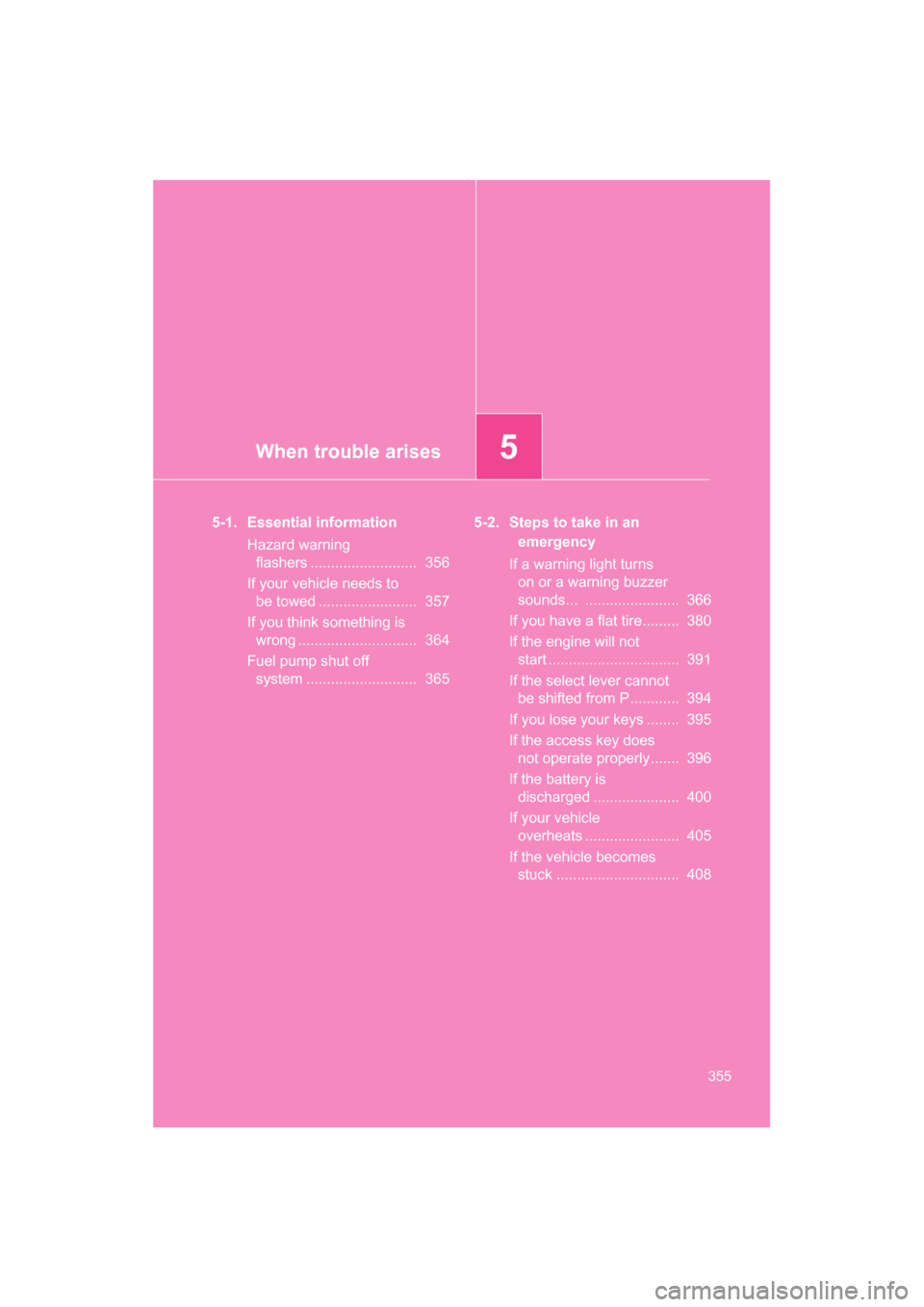
When trouble arises5
355
5-1. Essential informationHazard warning flashers .......................... 356
If your vehicle needs to be towed ........................ 357
If you think something is wrong ............................. 364
Fuel pump shut off system ........................... 365 5-2. Steps to take in an
emergency
If a warning light turns on or a warning buzzer
sounds... ....................... 366
If you have a flat tire......... 380
If the engine will not start ................................ 391
If the select lever cannot be shifted from P ............ 394
If you lose your keys ........ 395
If the access key does not operate properly....... 396
If the battery is discharged ..................... 400
If your vehicle overheats ....................... 405
If the vehicle becomes stuck .............................. 408
Page 356 of 488
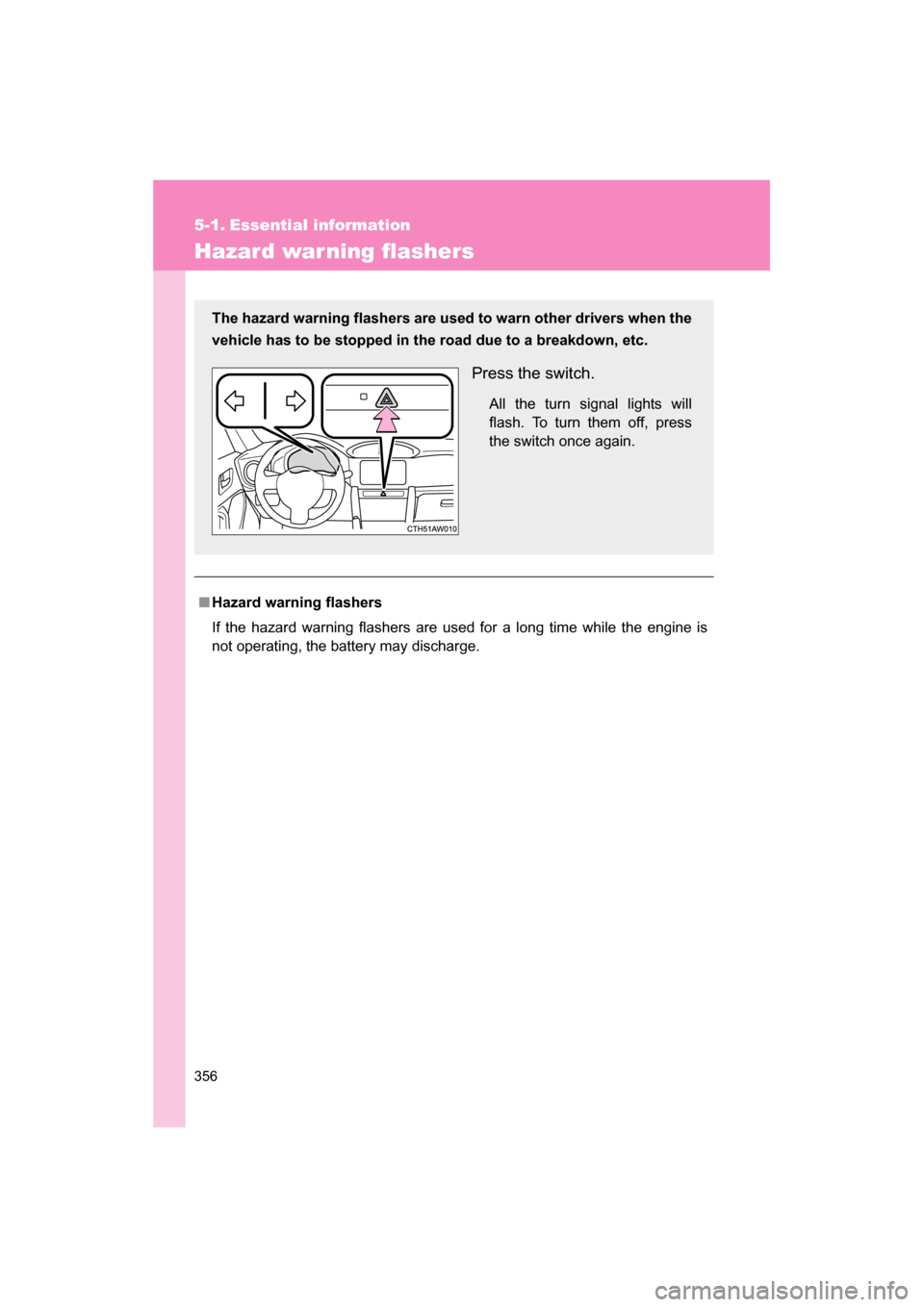
356
5-1. Essential information
Hazard war ning flashers
■Hazard warning flashers
If the hazard warning flashers are used for a long time while the engine is
not operating, the battery may discharge.
The hazard warning flashers are used to warn other drivers when the
vehicle has to be stopped in the road due to a breakdown, etc.
Press the switch.All the turn signal lights will
flash. To turn them off, press
the switch once again.
Page 357 of 488
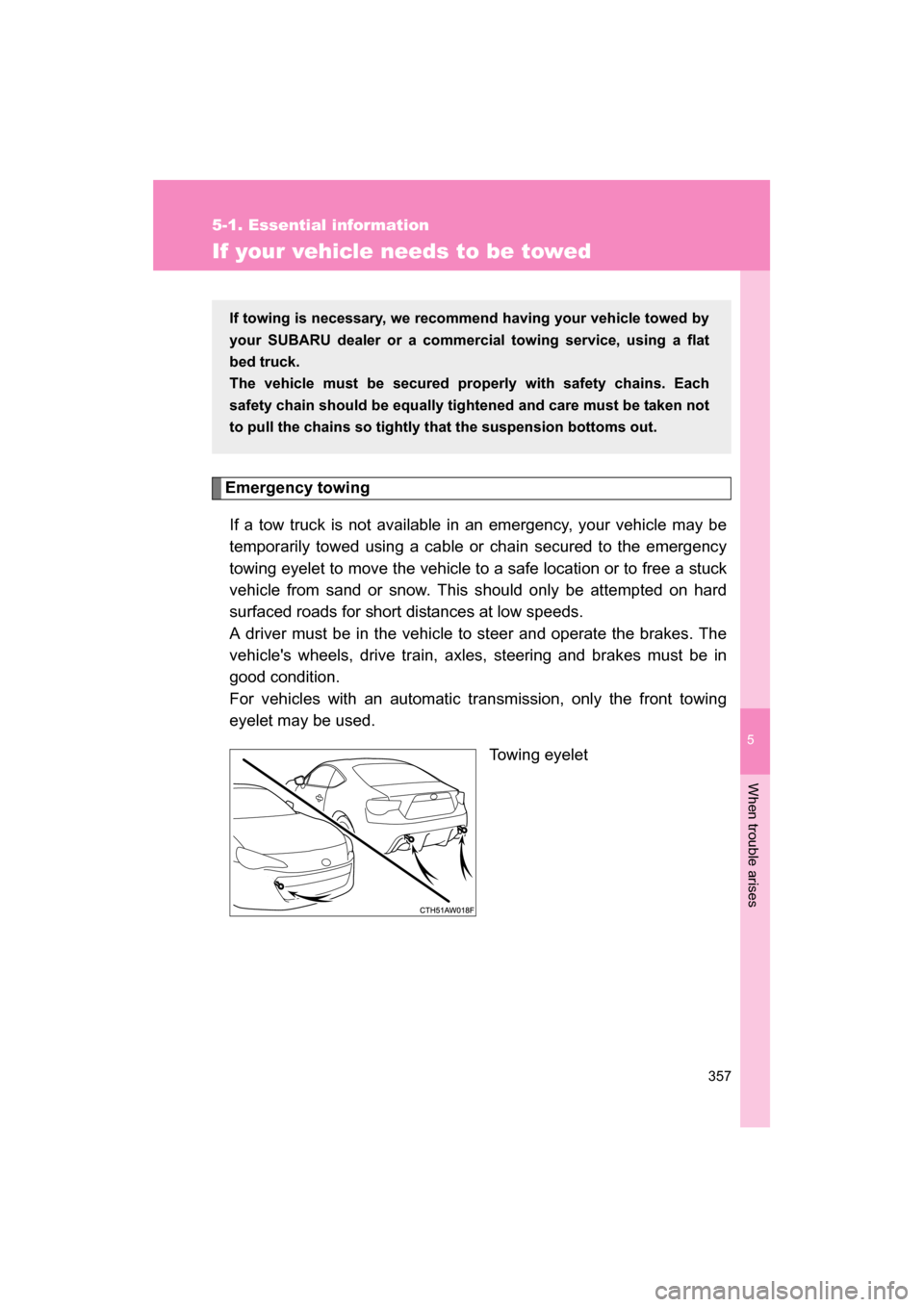
5
When trouble arises
357
5-1. Essential information
If your vehicle needs to be towed
Emergency towingIf a tow truck is not available in an emergency, your vehicle may be
temporarily towed using a cable or chain secured to the emergency
towing eyelet to move the vehicle to a safe location or to free a stuck
vehicle from sand or snow. This should only be attempted on hard
surfaced roads for short distances at low speeds.
A driver must be in the vehicle to steer and operate the brakes. The
vehicle's wheels, drive train, axles, steering and brakes must be in
good condition.
For vehicles with an automatic transmission, only the front towing
eyelet may be used. Towing eyelet
If towing is necessary, we recommend having your vehicle towed by
your SUBARU dealer or a commercial towing service, using a flat
bed truck.
The vehicle must be secured properly with safety chains. Each
safety chain should be equally tightened and care must be taken not
to pull the chains so tightly that the suspension bottoms out.
Page 358 of 488
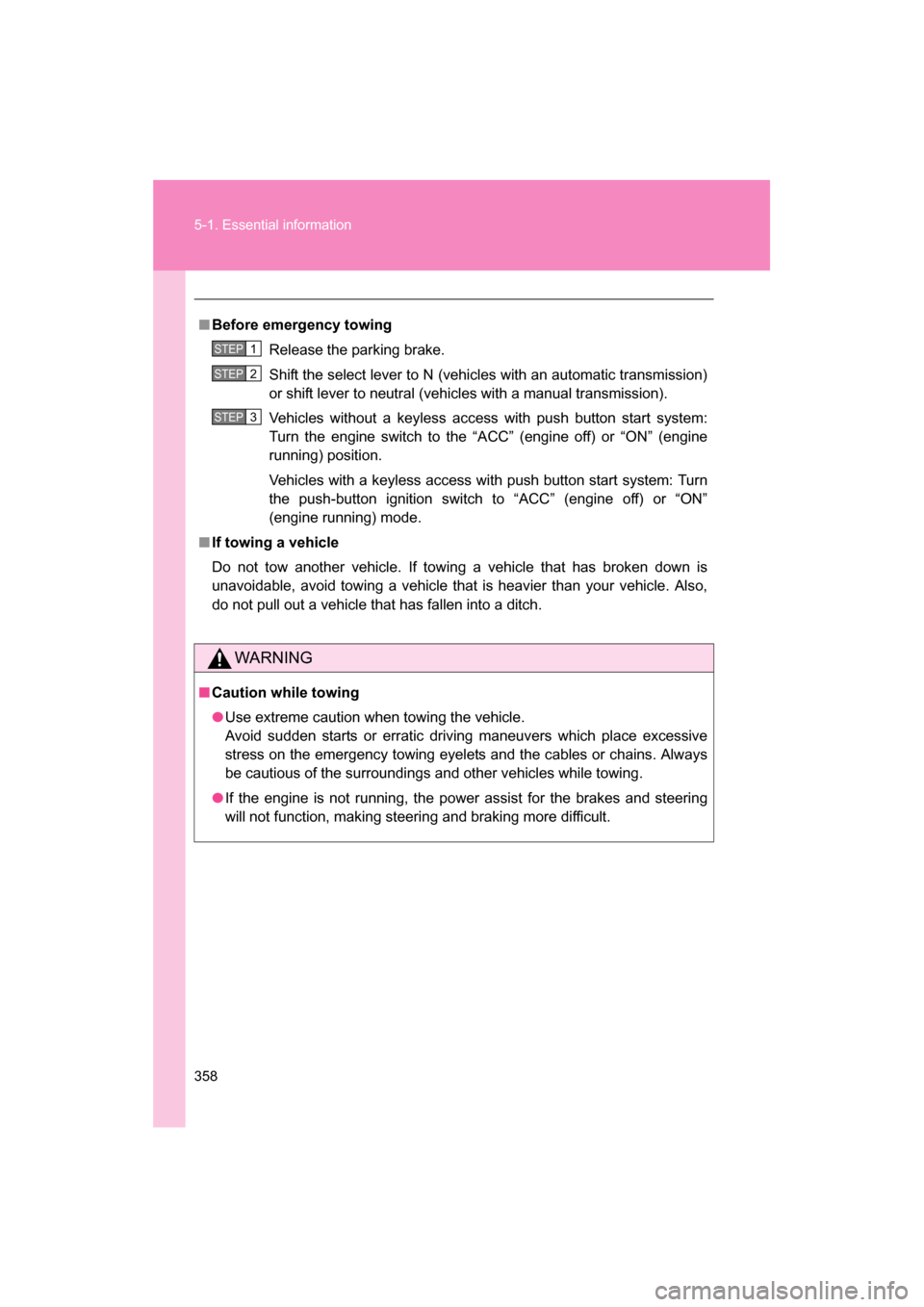
358
5-1. Essential information
■Before emergency towingRelease the parking brake.
Shift the select lever to N (vehicles with an automatic transmission)
or shift lever to neutral (vehicles with a manual transmission).
Vehicles without a keyless access with push button start system:
Turn the engine switch to the “A CC” (engine off) or “ON” (engine
running) position.
Vehicles with a keyless access with push button start system: Turn
the push-button ignition switch to “ACC” (engine off) or “ON”
(engine running) mode.
■If towing a vehicle
Do not tow another vehicle. If towing a vehicle that has broken down is
unavoidable, avoid towing a vehicle that is heavier than your vehicle. Also,
do not pull out a vehicle that has fallen into a ditch.
WARNING
■Caution while towing
●Use extreme caution when towing the vehicle.
Avoid sudden starts or erratic driving maneuvers which place excessive
stress on the emergency towing eyelets and the cables or chains. Always
be cautious of the surroundings and other vehicles while towing.
●If the engine is not running, the power assist for the brakes and steering
will not function, making steering and braking more difficult.
STEP 1
STEP 2
STEP 3
Page 359 of 488
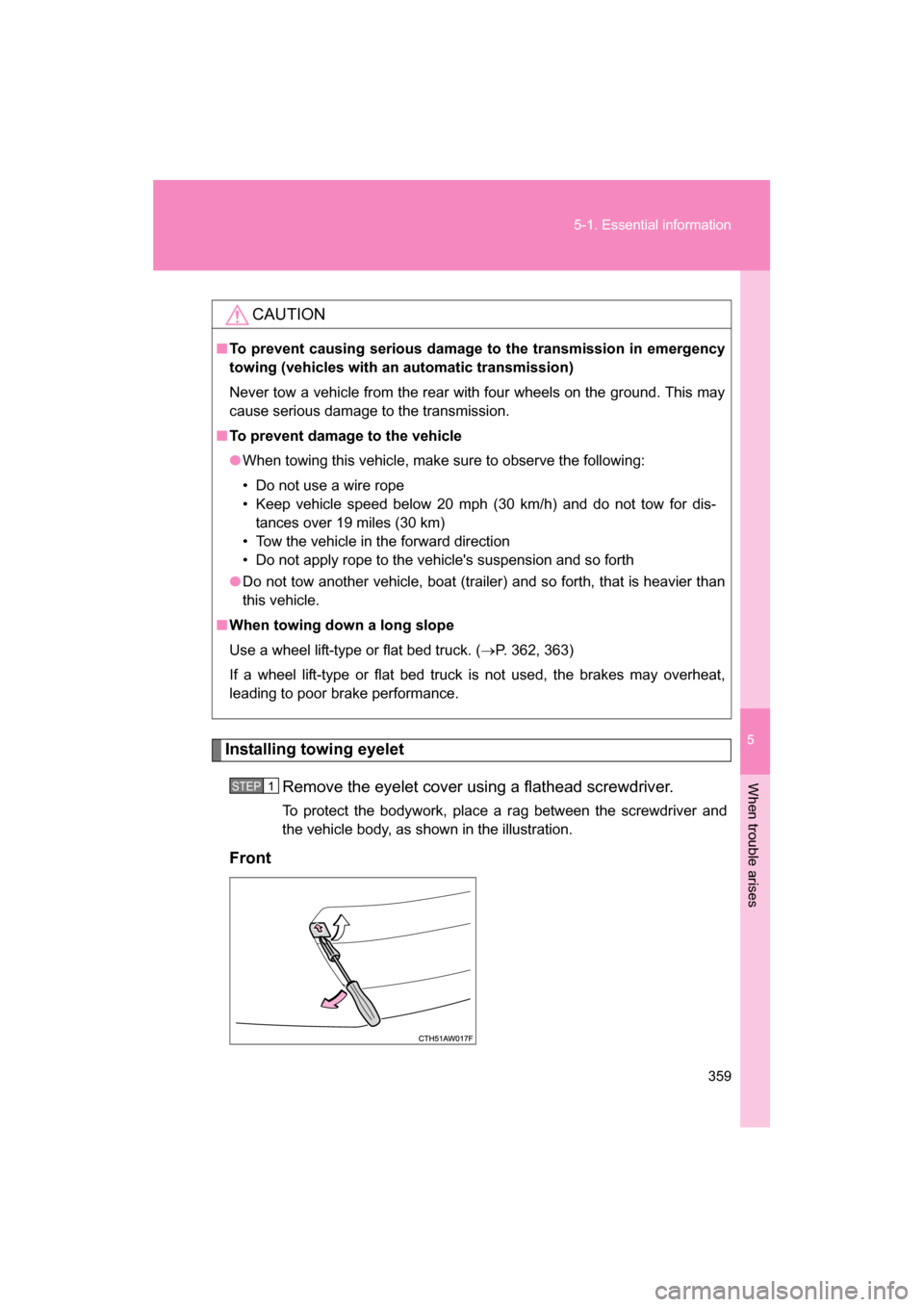
5
When trouble arises
359
5-1. Essential information
Installing towing eyeletRemove the eyelet cover using a flathead screwdriver.
To protect the bodywork, place a rag between the screwdriver and
the vehicle body, as shown in the illustration.
Front
CAUTION
■To prevent causing serious damage to the transmission in emergency
towing (vehicles with an automatic transmission)
Never tow a vehicle from the rear with four wheels on the ground. This may
cause serious damage to the transmission.
■To prevent damage to the vehicle
●When towing this vehicle, make sure to observe the following:
Page 360 of 488
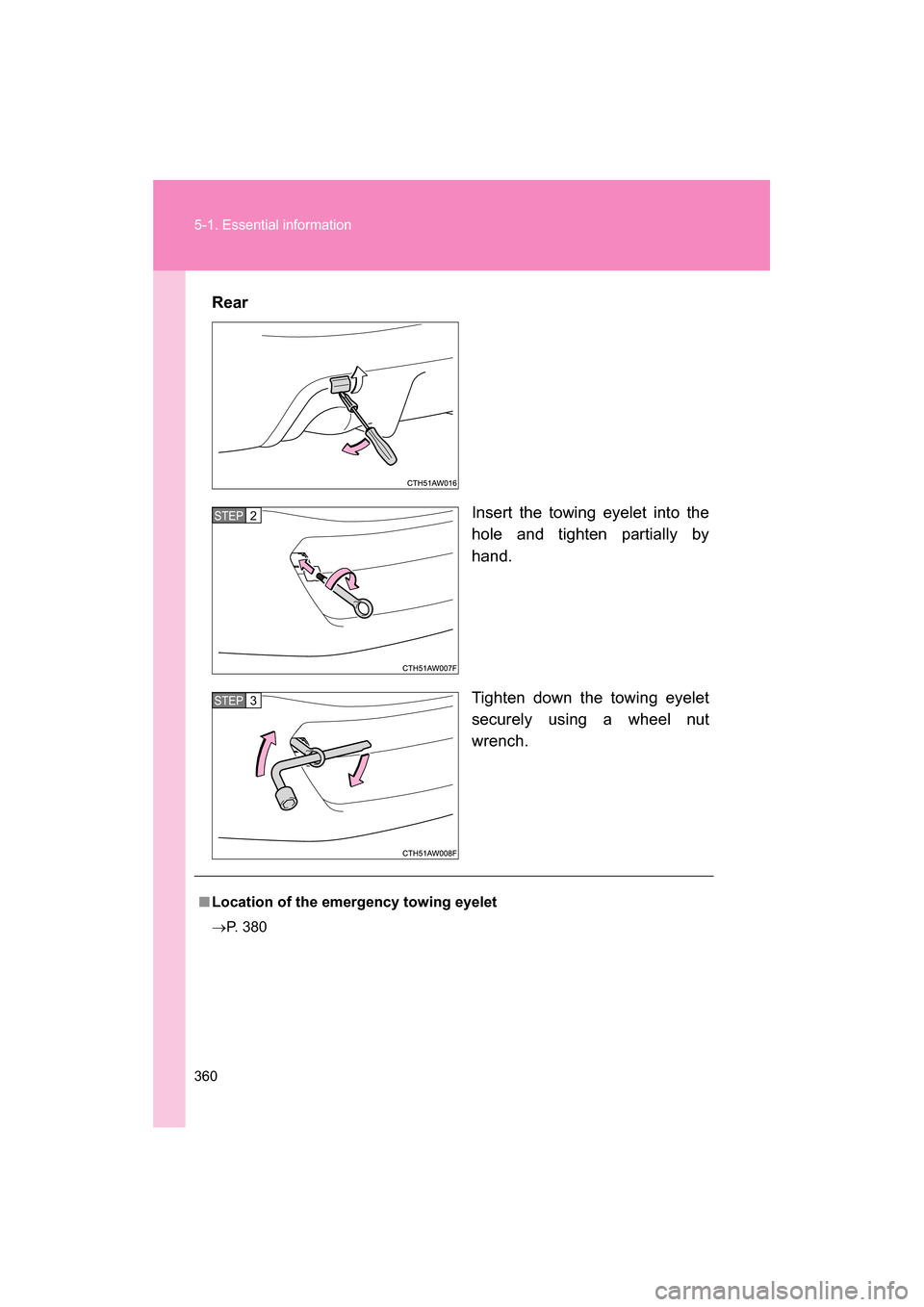
360
5-1. Essential information
RearInsert the towing eyelet into the
hole and tighten partially by
hand.
Tighten down the towing eyelet
securely using a wheel nut
wrench.
STEP 2
STEP 3
■Location of the emergency towing eyelet
→P. 380